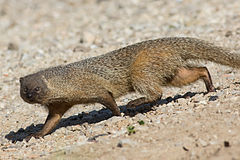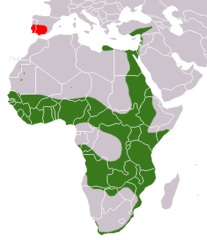Mangusta egipska
| Herpestes ichneumon[1] | |||||
| (Linnaeus, 1758) | |||||
 | |||||
| Systematyka | |||||
| Domena | |||||
|---|---|---|---|---|---|
| Królestwo | |||||
| Typ | |||||
| Podtyp | |||||
| Gromada | |||||
| Podgromada | |||||
| Infragromada | |||||
| Rząd | |||||
| Podrząd | |||||
| Rodzina | |||||
| Podrodzina | Herpestinae | ||||
| Rodzaj | |||||
| Gatunek | mangusta egipska | ||||
| |||||
| Kategoria zagrożenia (CKGZ)[32] | |||||
 | |||||
| Zasięg występowania | |||||
(c) IUCN Red List of Threatened Species, species assessors and the authors of the spatial data., CC BY-SA 3.0 środowisko rodzime rejon introdukcji | |||||
Mangusta egipska[33], ichneumon[34], szczur faraona (Herpestes ichneumon) – gatunek drapieżnego ssaka z podrodziny Herpestinae w obrębie rodziny mangustowatych (Herpestinae).
Taksonomia
Gatunek po raz pierwszy zgodnie z zasadami nazewnictwa binominalnego opisał w 1758 roku szwedzki przyrodnik Karol Linneusz nadając mu nazwę Viverra ichneumon[2]. Holotyp pochodził z Egiptu[35].
Rozpoznano do dziesięciu podgatunków[35], ale konieczna jest rewizja taksonomiczna[36][37]. Autorzy Illustrated Checklist of the Mammals of the World uznają ten gatunek za monotypowy[37].
Etymologia
- Herpestes (Herpertes): gr. ἑρπηστης herpēstēs „pełzacz”, od ἑρπω herpō „pełzać”; prawdopodobnie w aluzji do zwyczajów mangusty, szczególnie jej pogoni za swoją ofiarą. Sugerowano również połączenie greckich słów: ερπ erp „gad, wąż”; εδεστης edestēs „zjadacz”, od εδω edō „jeść”[38].
- ichneumon: gr. ιχνευμων ikhneumōn „tropiciel”, od ιχνευω ikhneuō „tropić, sledzić” [39].
Zasięg występowania
Mangusta egipska występuje na Półwyspie Iberyjskim, północnej Afryce i Bliskim Wschodzie w południowej Turcji, Syrii, Libanie, Jordanii i Izraelu; Czarnej Afryce od Senegalu i Gambii na wschód do Sudanu, Etiopii, Somalii i Kenii oraz na południe do Gabonu, Angoli, północnej Namibii, północnej Botswany, północnego Zimbabwe, Mozambiku i Południowej Afryce[37]. Występowanie w Europie (Portugalia i Hiszpania) prawdopodobnie spowodowane jest introdukcją z północnej Afryki[37].
Morfologia
Długość ciała (bez ogona) samic 50–58 cm, samców 55,7–61 cm, długość ogona samic 43,5–56,3 cm, samców 44,7–61 cm, długość ucha samic 3–4,2 cm, samców 2,5–3,8 cm, długość tylnej stopy samic 8,9–11,4 cm, samców 9,5–11,5 cm; masa ciała samic 2,2–4,1 kg, samców 2,6–4,1 kg[36]. Sierść dość długa, ubarwiona rudo-brązowo, pysk długi, spiczasty. Wzór zębowy: I C P M = 40[36].
Ekologia
Tryb życia głównie nocny. Żyje w wykopanych przez siebie norach, parami lub w grupach rodzinnych.
Pożywienie stanowią głównie drobne kręgowce oraz pokarm roślinny, zwłaszcza owoce. Często atakuje jadowite węże, m.in. kobry, których jest zaciętym wrogiem. Czasem napada na ptactwo domowe. Ciąża trwa ok. 2 miesięcy, samica rodzi 2-5 młodych. W celu wytępienia węży jadowitych sprowadzono mangustę egipską m.in. do Włoch.
Znaczenie
Mangusta egipska była jednym z pierwszych drapieżników, które udało się oswoić i wszechstronnie użytkować starożytnym Egipcjanom gdzie była czczona jako zwierzę święte.
Przypisy
- ↑ Herpestes ichneumon, [w:] Integrated Taxonomic Information System [online] (ang.).
- ↑ a b C. Linnaeus: Systema naturae per regna tria naturae, secundum classes, ordines, genera, species, cum characteribus, differentiis, synonymis, locis. Wyd. 10. T. 1. Holmiae: Impensis Direct. Laurentii Salvii, 1758, s. 43. (łac.).
- ↑ J.F. Gmelin: Systema naturae per regna tria naturae: secundum classes, ordines, genera, species, cum characteribus, differentiis, synonymis, locis. Wyd. 13. Cz. 1. Lipsiae: Impensis Georg. Emanuel. Beer., 1788, s. 85. (łac.).
- ↑ R. Kerr: The animal kingdom, or zoological system, of the celebrated Sir Charles Linnæus. containing a complete systematic description, arrangement, and nomenclature, of all the known species and varieties of the mammalia, or animals which give suck to their young. Class I, Mammalia. Edinburgh: A. Strahan, and T. Cadell, London, and W. Creech, 1792, s. 160. (ang.).
- ↑ B.G. de Lacépède: Tableau des divisions, sous-divisions, ordres et genres des mammifères. W: B.G. de Lacépède: Discours d’ouverture et de clôture du cours d’histoire naturelle, donné dans le Muséum national d’Histoire naturelle, l’an VII de la République, et tableaux méthodiques des mammifères et des oiseaux. Paris: Plassan, 1799, s. 7. (fr.).
- ↑ F. Tiedemann: Zoologie: zu seinen Vorlesungen entworfen. Allgemeine Zoologie, Mensch und Säugthiere. Landshut: In der Weberichen Buchhandlung, 1804, s. 364. (niem.).
- ↑ J.G. Fischer von Waldheim: Zoognosia tabulis synopticis illustrata, in usum praelectionum Academiae imperialis medico-chirugicae mosquensis edita. Cz. 3. Mosquae: Nicolai S. Vsevolozsky, 1814, s. xi, 188. (łac.).
- ↑ Geoffroy Saint-Hilaire 1818 ↓, s. 137.
- ↑ Geoffroy Saint-Hilaire 1818 ↓, s. 139 (przypis).
- ↑ J.V. Audouin: Description sommaire des mammifères carnassiers qui se trouvent en Égypte. W: France. Commission des sciences et arts d’Egypte: Description de l’Égypte, ou, Recueil des observations et des recherches qui ont été faites en Égypte pendant l’expédition de l’armée française. T. 2. Paris: Imprimerie impériale, 1817, s. 744. (fr.).
- ↑ J. Smuts: Dissertatio zoologica, enumerationem mammalium capensium continens: tribus tabulis adjunctis. Leidae: Apud J.C. Cyfveer, 1832, s. 19. (łac.).
- ↑ Smith 1834 ↓, s. 113.
- ↑ Smith 1834 ↓, s. 114.
- ↑ F. Cuvier: Ichneumon. W: È. Geoffroy Saint-Hilaire & F. Cuvier (redaktorzy): Histoire naturelle des mammifères: avec des figures originales, coloriées, dessinées d’aprèsdes animaux vivans. Paris: Chez A. Belin, 1842, s. ryc. i tekst. (fr.).
- ↑ J.E. Gray. Descriptions of some new or little known Mammàlia, principally in the British Museum Collection. „The Magazine of natural history”. New series. 1, s. 579, 1837. (ang.).
- ↑ J.E. Gray. Description of a new species of ichneumon (Herpestes) discovered in Spain. „The Annals and Magazine of Natural History”. 9 (55), s. 50, 1842. (ang.).
- ↑ E. Blyth: Catalogue of the Mammalia in the Museum Asiatic Society. Calcutta: Savielle & Cranenburgh, 1863, s. 50. (ang.).
- ↑ Gray 1865 ↓, s. 549.
- ↑ Gray 1865 ↓, s. 550.
- ↑ J.V. Barbosa du Bocage. Mammiféres d’Angola et du Congo. „Jornal de sciencias mathematicas, physicas e naturaes”. Segunda série. 2, s. 32, 1890. (fr.).
- ↑ A.J.E. Lönnberg. Notes on some Mammals collected in the Congo Free State by the Swedish Missionary K. E. Laman. „Arkiv för zoologi”. 4 (16), s. 3, 1908. (ang.).
- ↑ a b c A.F. Seabra. Sur quelques variétés de l’Herpestes ichneumon du Portugal. „Bulletin de la Société Portugaise des Sciences Naturelles”. 2, s. 286, 1908. (hiszp.).
- ↑ W.H. Osgood. Further new mammals from British East Africa. „Publication”. Zoological Series. 10 (3), s. 17, 1910. (ang.).
- ↑ A.J.E. Lönnberg. Mammals collected in Central Africa by Captain E. Arrhenius. „Kunglika Svenska vetenskapsakademiens handlingar”. Ny Följd. 58 (2), s. 61, 1917. (ang.).
- ↑ Á. Cabrera. Mamíferos africanos nuevos. „Boletín de la Real Sociedad Española de Historia Natural”. 24, s. 217, 1924. (hiszp.).
- ↑ A. Roberts. Some new S. African mammals and some changes in nomenclature. „Annals of the Transvaal Museum”. 11 (4), s. 249, 1926. (ang.).
- ↑ A. Roberts. Preliminary description of fifty-seven new forms of South African mammals. „Annals of the Transvaal Museum”. 15 (1), s. 4, 1932. (ang.).
- ↑ G.M. Allen. A checklist of African mammals. „Bulletin of the Museum of Comparative Zoology at Harvard College”. 83, s. 215, 1939. (ang.).
- ↑ A. Monard. Résultats de la mission scientique du Dr. Monard en Guinée Portugaise 1937-1938. IX. Carnivores. „Arquivos do Museu Bocage”. 11, s. 193–194, 1940. (port.).
- ↑ Rosevear 1974 ↓, s. 276.
- ↑ Rosevear 1974 ↓, s. 278.
- ↑ E. Do Linh San i inni, Herpestes ichneumon, [w:] The IUCN Red List of Threatened Species 2016 [online], wersja 2021-3 [dostęp 2022-04-23] (ang.).
- ↑ Nazwy zwyczajowe za: W. Cichocki, A. Ważna, J. Cichocki, E. Rajska-Jurgiel, A. Jasiński & W. Bogdanowicz: Polskie nazewnictwo ssaków świata. Warszawa: Muzeum i Instytut Zoologii PAN, 2015, s. 145–146. ISBN 978-83-88147-15-9. (pol. • ang.).
- ↑ K. Kowalski (red.), A. Krzanowski, H. Kubiak, B. Rzebik-Kowalska & L. Sych: Ssaki. Wyd. IV. Warszawa: Wiedza Powszechna, 1991, s. 189, seria: Mały słownik zoologiczny. ISBN 83-214-0637-8.
- ↑ a b D.E. Wilson & D.M. Reeder (redaktorzy): Species Herpestes ichneumon. [w:] Mammal Species of the World. A Taxonomic and Geographic Reference (Wyd. 3) [on-line]. Johns Hopkins University Press, 2005. [dostęp 2022-04-23].
- ↑ a b c J.S. Gilchrist, A.P. Jennings, G. Veron, & P. Cavallini (koordynator): Family Herpestidae (Mongooses). W: D.E. Wilson & R.A. Mittermeier (redaktorzy): Handbook of the Mammals of the World. Cz. 1: Carnivores. Barcelona: Lynx Edicions, 2009, s. 310–311. ISBN 978-84-96553-49-1. (ang.).
- ↑ a b c d C.J. Burgin, D.E. Wilson, R.A. Mittermeier, A.B. Rylands, T.E. Lacher & W. Sechrest: Illustrated Checklist of the Mammals of the World. Cz. 2: Eulipotyphla to Carnivora. Barcelona: Lynx Edicions, 2020, s. 416. ISBN 978-84-16728-35-0. (ang.).
- ↑ Palmer 1904 ↓, s. 321.
- ↑ Palmer 1904 ↓, s. 346.
Bibliografia
- É. Geoffroy Saint-Hilaire: Description des mammifères qui se trouvent en Egypte. W: France. Commission des sciences et arts d’Egypte: Description de l’Égypte, ou, Recueil des observations et des recherches qui ont été faites en Égypte pendant l’expédition de l’armée française. T. 2. Paris: Imprimerie impériale, 1817, s. 99–144. (fr.).
- A. Smith. African Zoology. „South African quarterly journal”. 2 (1), s. 113–128, 1834. (ang.).
- J.E. Gray. A revision of the genera and species of Viverrine animals (Viverridae) founded on the collection in the British Museum. „Proceedings of the Zoological Society of London”. 1865, s. 502–579, 1865. (ang.).
- T.S. Palmer. Index Generum Mammalium: a List of the Genera and Families of Mammals. „North American Fauna”. 23, s. 1–984, 1904. (ang.).
- D.G. Rosevear: The carnivores of West Africa. London: Trustees of the British Museum (Natural History), 1974, s. 1–548, seria: Publication no. 723. ISBN 0565-00723-8. (ang.).
Media użyte na tej stronie
Autor: (of code) -xfi-, Licencja: CC BY-SA 3.0
The Wikispecies logo created by Zephram Stark based on a concept design by Jeremykemp.
Autor: מינוזיג, Licencja: CC BY-SA 4.0
Herpestes ichneumon, Ashkelon National Park, Israel.
(c) IUCN Red List of Threatened Species, species assessors and the authors of the spatial data., CC BY-SA 3.0
Egyptian Mongoose (Herpestes ichneumon) range (green - native, red - introduced)




